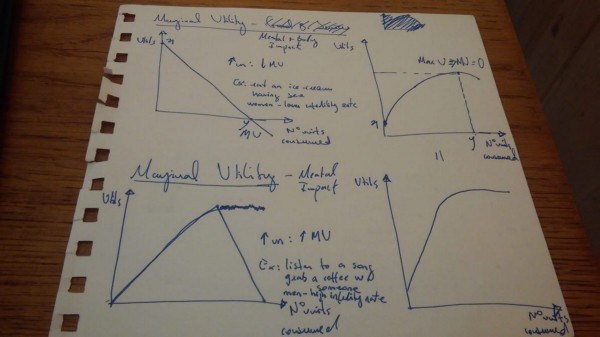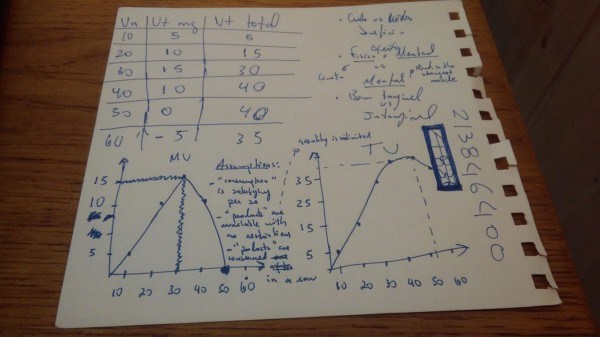A few days ago, the world witnessed the award of 2017 Nobel Prize for Economics to US economist Richard Thaler.
In other words, he has shed light on how human traits and states of mind influence, to a large extent, an individual’s rational decision-making. At a news conference after the prize announcement in Stockholm, the 72-year old Professor stressed that “in order to do good economics, you have to keep in mind that people are human.”
In this sense, one can read between the lines that human behaviour is oftentimes irrational, which ultimately challenges well-consolidated assumptions in economic theory.
When asked how would he spend the prize money of $1.1m, the best-selling author brilliantly responded “I will try to spend it as irrationally as possible.”
Defying Marginal Utility
Following Professor Thaler’s reasoning, I decided to defy a long-lasting basic economic concept (as far as possible): marginal utility. How did the idea come to my mind?
Simple.
Like most of freshmen studying business or economics, I was taught marginal utility conception in one of my first classes at university.
Although we were all horny with our head in the clouds, the meaning of marginal utility was quite straightforward and intuitive to me at that time. Shall we recap?
Under Consumer Theory, one can define utility as the degree of satisfaction that a certain good or service gives to our needs.
Bearing in mind that each one of us has their own preferences for different products, the value we give to them is indeed subjective and hard to generalize.
However, we need to find mechanisms to simplify reality as well as its complex phenomena.
Having said that, there’s 2 main questions economists intend to solve:
- How many units of a certain good or service should we consume to maximize our utility?
- How can we translate that information into relevant knowledge regarding one’s buying decision making process?
Defining Marginal Utility and Total Utility
It’s at this point that academics resort to the marginal utility concept:
Marginal Utility (MU) — additional satisfaction a consumer obtains from consuming one extra unit of a certain good or service.
Total Utility (TU) — accumulated satisfaction a consumer obtains from consuming a certain quantity of a certain good or service.
By rule, marginal utility displays a negative variation for each extra unit consumed. For instance, the more I eat ice-creams, the less satisfaction I get over time. If I keep eating them, the outcome will be nothing but feeling bad from my stomach preventing me from getting further satisfaction.
In this case, marginal utility reaches negatives values and my total utility starts to decrease (law of diminishing marginal utility).

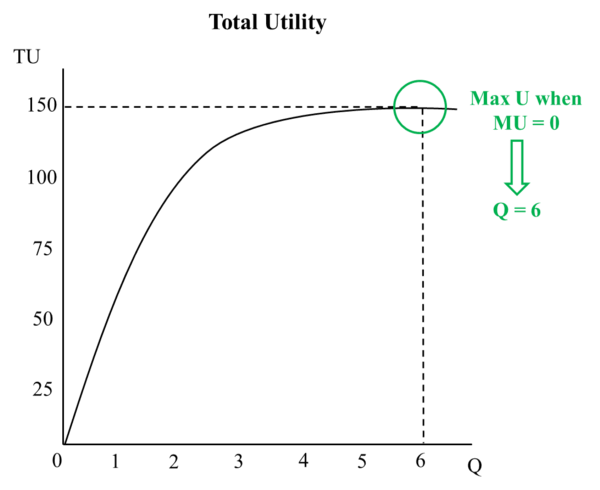
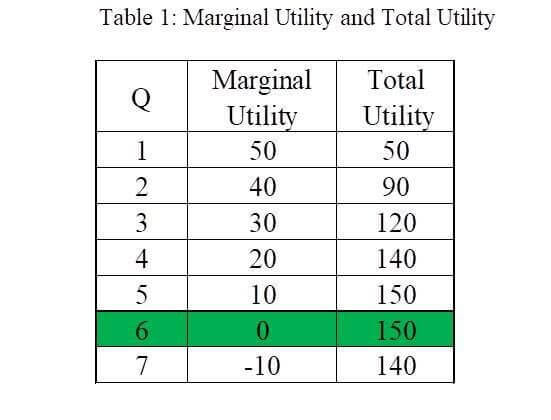
In the example above, one should consume 6 units of a certain good or service to maximize their utility (when the marginal utility = 0).
As a result, the conclusions are as follows:
a. TU is maximized when MU = 0
b. TU decreases when MU < 0
I remember being seated in one of the back rows of Economics I class.
Fred, a musician friend of mine, raised his hand and asked our teaching assistant the following:
“Can’t MU have a positive variation from the moment one begins consuming a good or service? Imagine like I’m listening to a song. I may like it as I keep listening to it, over and over! Because I can identify new sounds, rhythms, instruments… This will increase my enjoyment over time.” My inner reaction was “fuck… Nice thought! That’s why I love creative people. They surely know how to twist things!”
The Theoretical Model
This was the starting point to build up on my “theoretical model”. Under specific circumstances, I believed that the MU from consuming an extra unit of certain goods or services could surpass the satisfaction of the previous unit consumed!
In the meantime, I travelled to Seville with my friend André for a couple of days. We were both at Plaza Nueva with Christina, a German friend we had just met at our hostel. Sevillanos and tourists were enjoying a hot “Noche Blanca” (white night) festival walking by one of the city’s most magnificent squares.
While admiring the magical lighting around the City Hall, our philosophers’ personas came to the surface. Amid deep talks about life, relationships and happiness, the taste of my pistachio and hazelnut ice-cream not only activated my senses but also Fred’s insightful comment in regard to MU (yes… I know how random this is).
Therefore, I took that introspective atmosphere to share the “ice-cream vs song utility” example with André and Christina.
Nonetheless, I wanted to explore it further… How could I distinguish a good or service whose extra unit consumed generates more vs less satisfaction than the previous one consumed?
What is the criterion, the critical factor for an increasing vs decreasing variation of MU? It had to be something related to psychology (heuristic, sensorial), human behaviour…
“Let’s brainstorm” — I said.
Tangible vs intangible goods; intellectual vs superfluous goods; short-term vs long-term satisfaction… It didn’t work.
After several back and forward ideas with my mother, the “EUREKA” moment finally arrived! But before presenting my conclusions, there are a few assumptions / limitations that should be considered:
- The consumption of a certain good/service is satisfying per se;
- The unit consumption of a certain good/service occurs without delay;
- Consumer Choice is not affected by exogenous variables (quantity available of good/service x; quantity available of substitutes; price of good/service x; price of substitutes; budget constraints).
Conclusions
- Case 1: Goods or services whose consumption involves mental and physical dimensions. This case sustains the MU rules we know so far: the more we consume of a good or service, the less satisfaction (utility) we get compared to the previous consumption over time.

Ex.: having sex; exercising; eating.
Let’s pick up on the “exercising” example. One can assume that a “unit consumed” is the act of doing sports for a given period of time (1 hour).
When someone exercises himself for 2h and 3h (2nd and 3rd units consumed), the satisfaction obtained will fall due to mental tiredness (mental dimension) alongside fatigue or muscle pain (physical dimension). Consequently, the more hours I exercise (extra unit consumed), the more uncomfortable and tired I will be (less satisfaction and decreasing variation of MU).
- Case 2: Goods or services whose consumption involves only a mental dimension. This case sustains a new approach as far as MU is concerned: the more we consume of a good or service, the more satisfaction (utility) we get compared to the previous consumption until a certain period of time. Then, Case 1 will prevail.
Ex.: listening to a song; reading a book; contemplating a landscape; grabbing a coffee with someone new.
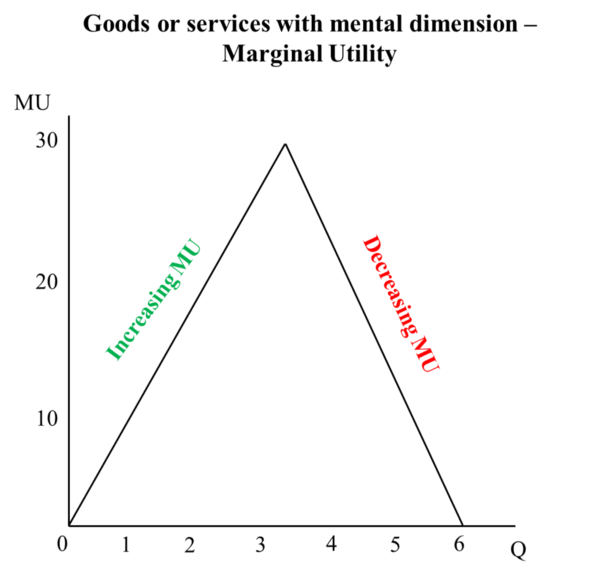
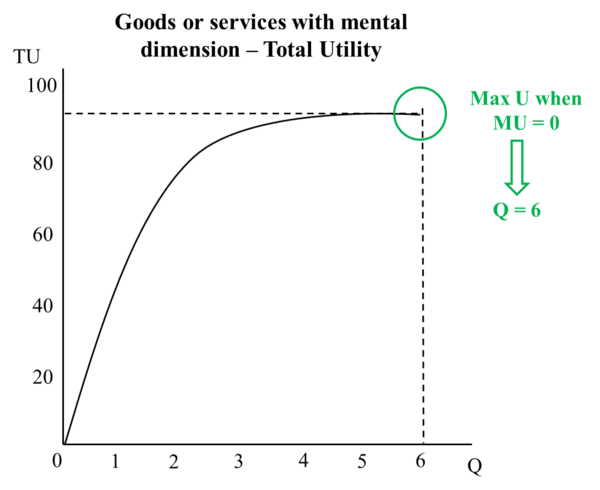
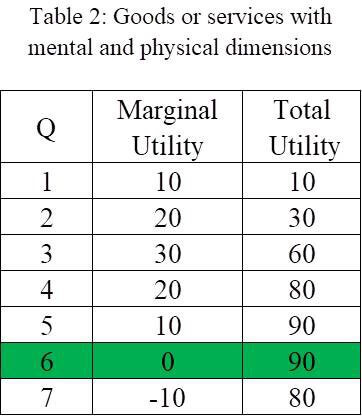
In the example above, the consumer obtains a higher degree of satisfaction from each extra unit consumed until Q=3 (>0 slope line). From that moment on, each extra unit originates a lower degree of satisfaction (<0 slope line). After Q=6, the consumer becomes worse-off since MU = 0.
You’ve probably heard the saying “The brain is the strongest muscle in the human body”.
Despite the hard time trying to quantify “units” from the given examples, the truth is that…
…we can reach a higher degree of satisfaction by consuming more of certain goods or services.
a) Has it ever happened to you to be in love with a song that you can’t stop listening to? If you’ve played a musical instrument I’m sure you know what I’m talking about.
b) Imagine you read a book more than once. Haven’t you taken new and enriching ideas from the second read?
c) What about not being able to take your eyes off the ocean or mountains? You look once and some feelings arise to your mind and soul; you look twice and you end up noticing 3 different tons of blue in the sea water. Isn’t it pleasing and delightful?
d) When you’re into someone you meet for the first time, don’t you feel the desire to be with that person more and more? Because each time you are with him/her there are new stories to tell, experiences to share, things to discover about each other.
Yet, if such “consumptions” are maintained infinitely…
…there will be a point where an extra unit consumed leads to less satisfaction (MU negative variation) and, ultimately, boredom (MU negative values). The process will therefore return to the original model (Case 1).
I want to conclude my stream of reasoning giving you one last example about a common thought. “Why do men cheat more on their wives than the opposite situation?” We all have our own theories but let’s apply the logic of Case 1) and Case 2) which I consider to be “controversial”…
One thing that unarguably differentiates men and women is the latter biological condition to give birth.
How can we frame that fact given the new MU model? Actually, it’s a physical dimension which forwards us to Case 1) where one obtains less satisfaction for each extra unit consumed.
In this example let’s define “unit” as the number of times a person cheats on his/her partner.
When a woman has several intercourse relationships with someone other than her partner, she obtains less sexual satisfaction each time she does it.
Why?
There’s the chance she may get pregnant (even resorting to contraceptive methods) and then having to deal with its aftermath. From a broken relationship to raise a child with someone undesired, not to mention the physical demands of a pregnancy.
In the end, the MU of an extra betrayal exhibits a negative evolution. On the other hand, a man who cheats on his wife over and over doesn’t “suffer” from any physical constraint. He only gets the benefit which is increasing sexual pleasure. Therefore, the marginal utility of an extra betrayal will increase.
The idea here is not to open a discussion about moral judgements of men and women. Instead, my goal is to determine the feasibility of an economic theory that has been subject to a human approach founded on mental and physical dimensions.
Do you have any examples of goods/services where this model may suit? Does it actually make sense? And which other variables could we integrate?
PS: Draft of a thinking mind
